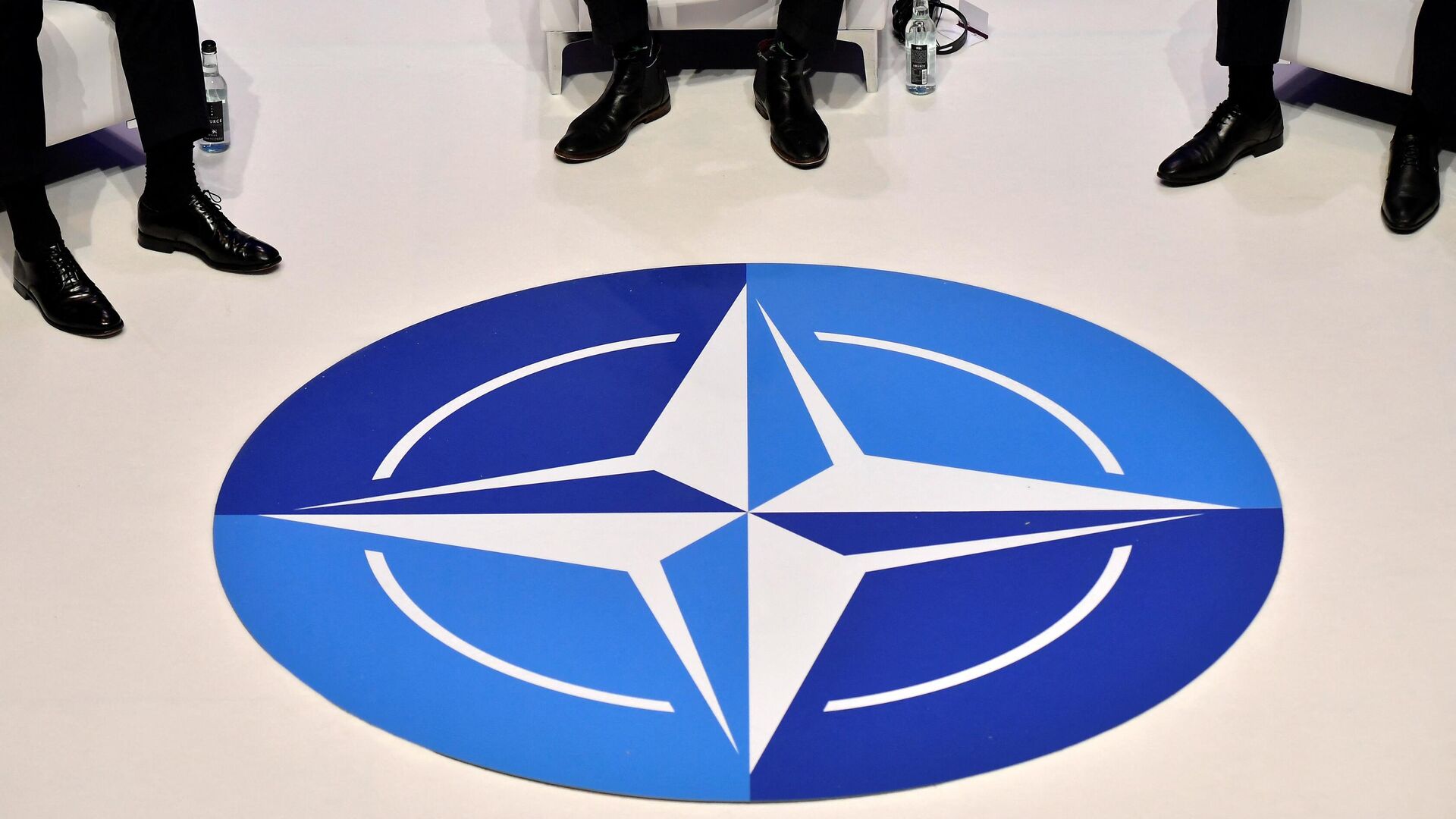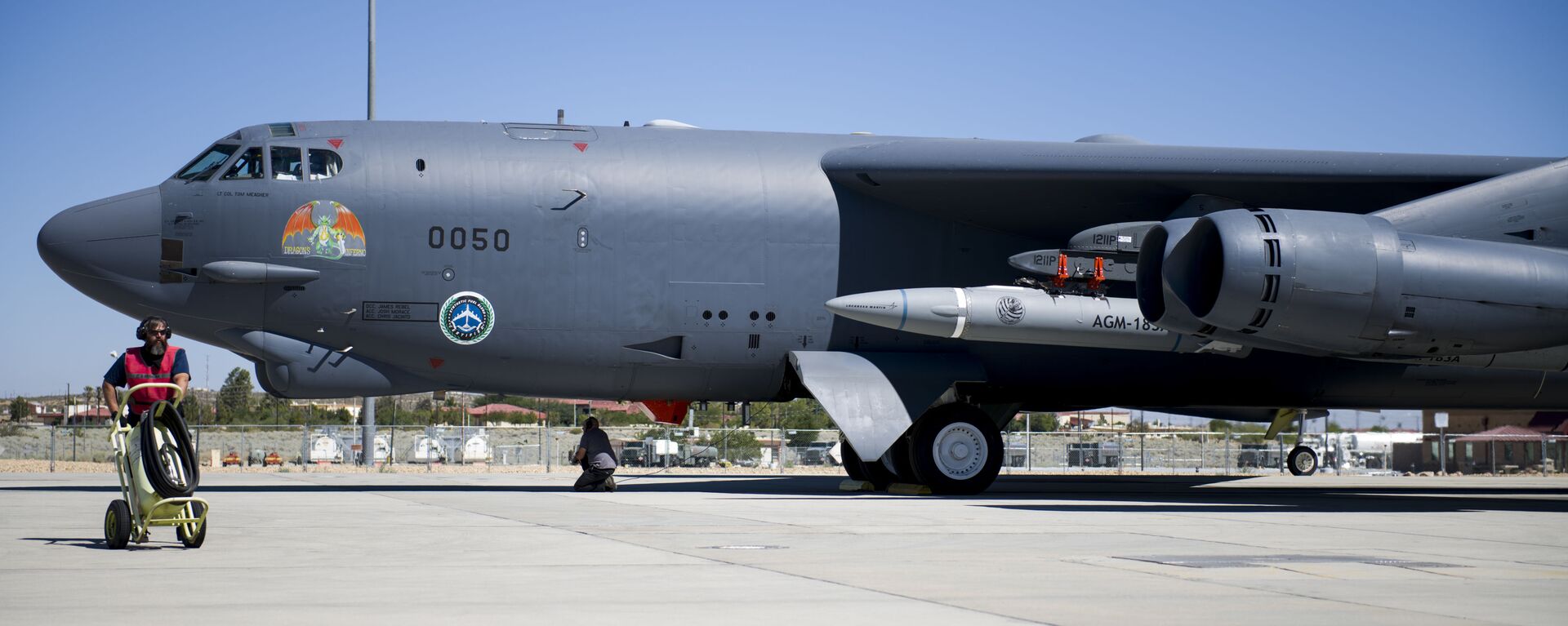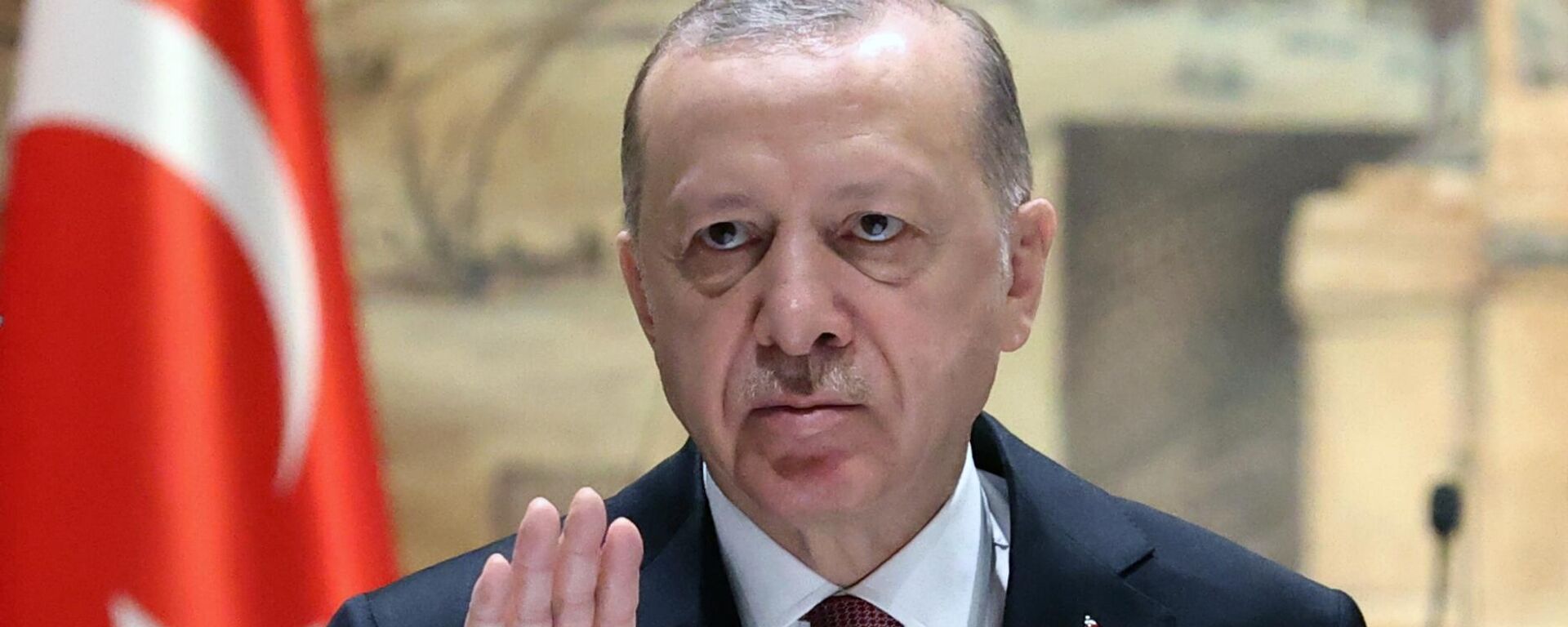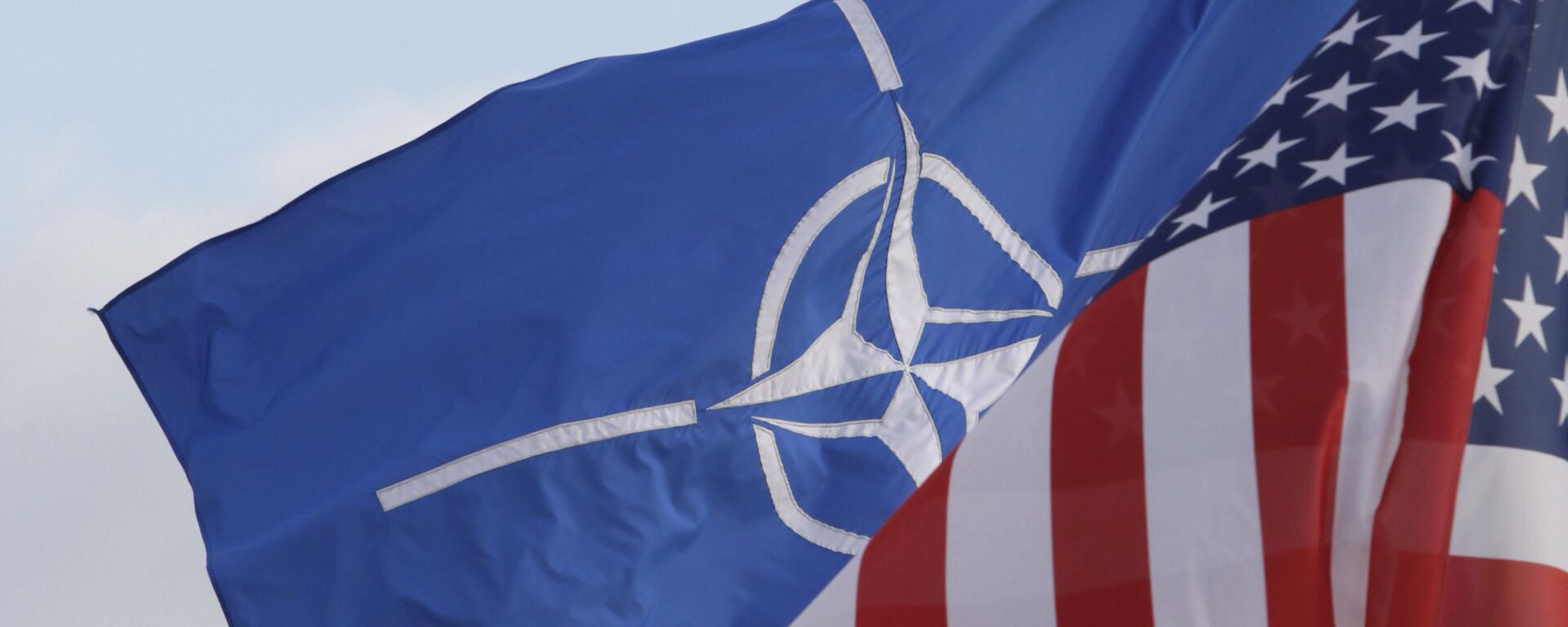https://sputnikglobe.com/20220628/from-non-existent-enemies-to-internal-bureaucratic-squabbles-five-reasons-nato-is-obsolete-1096761201.html
From Non-existent Enemies to Internal Bureaucratic Squabbles: Five Reasons NATO is Obsolete
From Non-existent Enemies to Internal Bureaucratic Squabbles: Five Reasons NATO is Obsolete
Sputnik International
Leaders of the North Atlantic Treaty Organization are getting ready to meet in Madrid, Spain for the bloc’s 32nd summit. The meeting is expected to include the... 28.06.2022, Sputnik International
2022-06-28T15:18+0000
2022-06-28T15:18+0000
2022-06-28T15:27+0000
nato
obsolete
https://cdn1.img.sputnikglobe.com/img/07e6/06/1c/1096760814_0:0:3365:1893_1920x0_80_0_0_6e6ed572613cf9f3e732b7c48a1ecaa0.jpg
NATO has come a long way since its creation in 1949, growing from 12 founding members, among them the US, the UK, Belgium, Canada, Denmark, France, Iceland, Italy, Luxembourg, the Netherlands, Norway and Portugal, to 30 today, including Greece and Turkey, Germany, Spain, every member of the former Warsaw Pact, three ex-Soviet republics and four of the six republics of the former Yugoslavia.But does the bloc continue to meet its primary stated purpose, that is, safeguarding “the freedom and security of all its members by political and military means”? Below are five good reasons why, from a security standpoint, the alliance is an obsolete dinosaur that makes its members less, not more safe.Anyone Feel Safer?NATO’s aggressive expansion agenda, justified by the so-called ‘open-door’ policy on membership, is arguably one of the central causes behind the crisis in Ukraine, with Moscow spending years warning the Western bloc that it considers Ukraine a “red line” behind which Russia has “nowhere to fall back to.”“I have already said – they’ll put missile systems in Ukraine, 4-5 minutes flight time to Moscow. Where can we move? They have simply driven us to such a state that we have to tell them: stop. That’s the whole point,” Russian President Vladimir Putin said in an interview in December 2021, referring to the Russia-proposed security draft treaties sent to the US and NATO that month. The twin proposals, which included a demand that NATO halt its eastward expansion, limits on the deployment of weapons and troops, and an explicit affirmation by both sides that they do not consider one another enemies, were rejected by Washington and its allies.The advent of new armaments, including nuclear-armed hypersonic missile systems, has guaranteed Russia strategic leverage, albeit as a last resort to enemy aggression. After the United States renounced the 1972 Anti-Ballistic Missile Treaty in 2002, Moscow dusted off Soviet plans for hypersonic missiles capable of evading all existing and prospective air defense systems. These programs bore fruit in late 2017, when the Kinzhal hypersonic nuclear-capable aero-ballistic air to surface missile stepped into service with the Russian military. Other Russian systems, including the Avangard hypersonic glide vehicle, the Zircon scramjet-powered anti-ship cruise missile, and the new RS-28 Sarmat intercontinental ballistic missile system, promise to help maintain the strategic balance between Russia and the Western bloc for decades to come.China, Washington’s other strategic competitor, unveiled its DF-ZF hypersonic glide vehicle in 2019. But the US’s outsized defense spending has helped Washington in gaining the upper hand in the hypersonic race, with none of the half-dozen US hypersonic weapons designs in development anywhere close to being fielded.Spending Our Way to BankruptcyMajor NATO members including Germany, Italy, Spain, Portugal and the Netherlands have spent years dragging their feet on the bloc’s 2014 requirement to boost defense spending to at least 2 percent of GDP. The Ukraine crisis and renewed bloc pressure have helped overcome resistance, with the European Union alone announcing increases in spending of some $211.5 billion over the coming four years. In the US, the Senate has approved a $817 billion military budget for fiscal year 2023, $45 billion more than President Biden requested.In the UK, Defense Secretary Ben Wallace has urged Prime Minister Johnson to push far beyond the 2 percent of GDP marker, recommending that 2.5 percent of GDP be committed to defense by 2028, and calling the Ukraine crisis a “1937 moment.” Other senior current and former British officials have taken a similar tone, with General Lord Dannatt, former chief of staff, demanding that Number 10 rethink its US-style “pivot” to Asia and dramatically ramp up spending on the Army to ends its status as the Royal Navy’s “poor cousin.”The ramped up defense spending comes against the backdrop of skyrocketing inflation, spiraling energy and food costs, and talk of a looming recession or even a stagflationary crisis (i.e. high inflation plus high unemployment and stagnant demand) on both sides of the Atlantic. Late last week, economists told the Financial Times that the risks of the US and Europe slipping into recession have gone up sharply amid energy price crunch and the US Federal Reserve’s measures to raise interest rates to try to get inflation under control. Earlier this year, German industry leaders warned that the coming economic crisis could be the European economic powerhouse’s worst since the Second World War.The disconnect between the economic crisis and the defense spending hikes have not gone unnoticed among US and European observers. In the United States, alternative media and pundits from both the left and the right have taken note of Washington’s spending priorities favoring Ukraine and the military-industrial complex instead of ordinary Americans.Last week, Massachusetts-based think tank National Priorities Project calculated that the planned increase in the Pentagon’s budget alone could almost fund President Biden’s ‘Build Back Better’ investment plan, which was scuppered by lawmakers over its perceived prohibitive cost. Across the Atlantic, the Leibniz Institute for Economic Research recently warned that German Chancellor Olaf Scholz’s “historic” 100 billion euro defense spending plan would be eaten up by inflation.Bureaucratic InfightingThe escalation of the crisis in Ukraine in February of 2022 and the Western alliance’s rushed attempt to continue its expansion along Russia's northern flank exposed a soft underbelly of bureaucratic infighting rarely seen before. In May, after the Finnish and Swedish governments formally applied for NATO membership, Turkish President Recep Tayyip Erdogan declared that Ankara would block the two countries’ applications until Helsinki and Stockholm ended their association with the Kurdistan Workers’ Party, a Turkish Kurdish political party and paramilitary group which Turkey classifies as terrorists, but which Finland and Sweden do not. Publicly, the Nordic nations have rejected this blatant interference in their internal affairs, leading their future status as part of the alliance uncertain and spurning NATO officials’ hopes of formally announcing their acceptance into the bloc at the Madrid summit.Turkey isn't the only country which has sought to take advantage of NATO’s requirement of unanimous support for new members being accepted. Last month, Croatian President Zoran Milanovic threatened to instruct Zagreb’s permanent representative to NATO to vote against Finland and Sweden’s admission into the alliance until an election law dispute in Bosnia was resolved. “If I am blamed, I am prepared. I have said before, Croats in Bosnia are more important to me than the entire Russian-Finnish border,” Milanovic said in a press conference, adding that Turkey has shown the way on “how to fight for national interests.”Destabilizer of Europe, and BeyondWhile it touts itself as a purely “defensive alliance” designed to protect its North American and European members and to “peacefully resolve disputes,” NATO has made numerous policy decisions over the past three decades which have destabilized its frontiers, including several wars of aggression against nations which posed no threat to any of its members.The Western bloc began shifting to an interventionist approach immediately after the Soviet collapse, deploying 60,000 troops and staging aerial operations over Bosnia beginning in 1992 during the bloody civil conflict between Bosnian Muslims, Catholic Croats and Orthodox Serbs. NATO’s operations included establishing a no-fly zone, which monitored the skies and stopped flights from the Federal Republic of Yugoslavia (multiple Serbian jets were shot down during this ‘air policing’ mission), attacking Bosnian Serb militias, and forcing the Serbs to surrender large tracts of territory, including Sarajevo, through the Dayton Accords of 1995.NATO’s successful ‘police action’ was followed up by 78 straight days of bombing of Yugoslavia in support of Kosovar Albanians in 1999, with the alliance launching over 2,300 missiles and dropping some 14,000 bombs, including cluster and uranium munitions in Kosovo and across the now former Yugoslavia. The aerial assault left as many as 5,000 people dead, and decades on, Serbia has reported a dramatic spike in oncological diseases attributed to the use of uranium cluster munitions, plus deliberate attacks on chemical plants and hazardous industrial facilities. The Balkan nation records nearly 60,000 new oncology patients each year, with a cancer rate 2.5 times above the European average for children.NATO’s justification for the 1999 bombing was a desire to ‘protect’ Kosovar Albanians from ethnic cleansing amid clashes between Albanian militias with Serbian army and police forces. After the bombing stopped and NATO ground troops were introduced, over 200,000 ethnic Serbs living in Kosovo had to leave their homes, with the United States establishing a massive, permanent military base in the region known as Camp Bondsteel.In 2001, after the 9/11 terror attacks on the Twin Towers in New York City and the Pentagon in Washington, the United States became the first NATO member to invoke Article 5 – the cornerstone section of the alliance’s treaty which deems an attack on one alliance member an attack on all and requires mobilization for effective defense. In the subsequent months, NATO forces invaded and occupied Afghanistan – the purported hiding place of 9/11 mastermind Osama bin Laden, with the mission of capturing him and bringing to justice, and ousting the Taliban government accused of sheltering him.Bin Laden was found living in a mansion in neighboring Pakistan about a decade later, and assassinated by a US Navy SEAL team. Meanwhile, after successfully toppling the Taliban and establishing a Western-friendly government, NATO’s mission in Afghanistan morphed into a nation-building operation that would ultimately last nearly 20 years, but crumble in weeks in August of 2021 as the US and its allies departed from the war-torn country. Brown University’s Costs of War project has estimated that some 176,000 people in Afghanistan died in the aftermath of the NATO invasion and occupation, with tens or even hundreds of thousands more feared to have perished from diseases, loss of access to food, water, and infrastructure. NATO and its allies lost more than 3,500 troops in the war, with the Costs of War Project calculating that the US military alone spent some $2.3 trillion on the conflict.In 2011, on the wave of the so-called ‘Arab Spring’ protests rocking much of the Middle East, a multi-state NATO-led coalition began another aerial campaign – this time in the North African nation of Libya. The 222-day bombing campaign, led by US, French, British, Canadian and Italian forces, was formally tasked with enforcing a United Nations resolution imposing a ‘no-fly zone’ prohibiting the forces loyal to Libyan leader Muammar Gaddafi from carrying out sorties against rebels. In practice, the operation saw NATO jets attacking thousands of Libyan Army targets, including over 600 tanks and armored vehicles, 400 artillery and rocket launcher installations, and other targets.Effectively, it was a foreign-backed military intervention to overthrow the country’s government. The campaign succeeded, and Gaddafi was eventually captured, tortured and executed by a gang of thugs. NATO jets dropped over 7,700 bombs and missiles on the country, once again including depleted uranium. As many as 2,000 civilians were killed as a direct result of the intervention, but the true chaos awaiting Libyans only began after the Gaddafi government’s collapse, with the country turned into a failed state controlled by warring factions, including al-Qaeda* and human trafficking criminal groups.Its Enemy No Longer ExistsThe North Atlantic alliance was founded at the dawn of the Cold War between the Soviet Union and the United States. In the aftermath of the Second World War, simmering mistrust between the erstwhile wartime allies boiled over into open hostility. In Europe, between 1947 and 1949, Moscow helped communists in Eastern European countries seize power, while in Western Europe, the US Central Intelligence Agency plotted to rig elections in Italy and France to prevent them from ‘turning red’, and helped Greek monarchists put down left-wing anti-fascist militants. NATO was founded in April 1949 to deter a potential Soviet invasion of Western Europe.After West Germany was invited into NATO in 1955, the USSR established the Warsaw Pact alliance. For the next thirty years, NATO and the Warsaw Pact would stare one another down across the so-called Iron Curtain frontier between East and West. However, in the mid-to-late 1980s, Soviet leader Mikhail Gorbachev began chipping away at Moscow’s realist approach to foreign policy, replacing it with an idealism that held that the superpowers could end the confrontation between them and converge on matters affecting all nations, such as poverty and environmental crises.But despite the loss of its main adversary – the Soviet threat to Western liberal democracy and capitalism, NATO did not cease to exist. In November 1992, charismatic former Arkansas governor Bill Clinton took the White House, and, two years later, not only committed to strengthen NATO, but reversed his predecessor George H.W. Bush’s position on the alliance’s growth. Bush’s secretary of state James Baker famously promised Gorbachev in 1990 that the Western alliance would not expand “one inch east” beyond the eastern frontiers of a reunified Germany. Clinton broke that promise, and in 1999, after several years of negotiations, the first round of the bloc’s eastward expansion began.Even Boris Yeltsin, the 1990s Russian President whose foreign minister Andrei Kozyrev once quipped that Russia “has no national interests” besides abstract “universal human values,” criticized Clinton’s NATO expansion plans. In 1994, in one of the first inklings of the current NATO-Russia tensions, Yeltsin asked “why” NATO was “sowing the seeds of mistrust” and threatening to plunge Europe into a new “cold peace.” Yeltsin never received a satisfactory answer, and in the decades to come, 14 Eastern European countries would be absorbed into the bloc, with each wave of expansion escalating tensions with Moscow further and further.* A terrorist group outlawed in Russia and many other countries.
https://sputnikglobe.com/20220214/lavrov-russia-partially-unsatisfied-with-us-response-to-security-proposals-1093021882.html
https://sputnikglobe.com/20220308/third-times-not-the-charm-pentagon-sweating-bullets-as-hypersonic-tests-fail-three-times-in-a-row-1093684981.html
https://sputnikglobe.com/20220401/austria-hungary-say-no-substitute-to-russian-gas-as-germanys-basf-warns-of-worst-crisis-since-wwii-1094388944.html
https://sputnikglobe.com/20220627/ex-turkish-intel-chief-therell-be-no-smooth-nato-entry-for-sweden--finland-at-madrid-summit-1096715985.html
https://sputnikglobe.com/20220324/we-should-go-in-on-the-ground-watch-biden-complain-nato-bombing-of-yugoslavia-not-ruthless-enough-1094148230.html
https://sputnikglobe.com/20220210/ex-aide-to-kohl-reveals-what-he-said-when-gorbachev-questioned-germanys-need-for-nato-membership-1092917193.html
https://sputnikglobe.com/20220527/nato-expansion-a-continuing-and-irreversible-landslide-1095800115.html
Sputnik International
feedback@sputniknews.com
+74956456601
MIA „Rossiya Segodnya“
2022
News
en_EN
Sputnik International
feedback@sputniknews.com
+74956456601
MIA „Rossiya Segodnya“
Sputnik International
feedback@sputniknews.com
+74956456601
MIA „Rossiya Segodnya“
nato, obsolete
NATO has come a long way since its creation in 1949, growing from 12 founding members, among them the US, the UK, Belgium, Canada, Denmark, France, Iceland, Italy, Luxembourg, the Netherlands, Norway and Portugal, to 30 today, including Greece and Turkey, Germany, Spain, every member of the former Warsaw Pact, three ex-Soviet republics and four of the six republics of the former Yugoslavia.
But does the bloc continue to meet its
primary stated purpose, that is, safeguarding “the freedom and security of all its members by political and military means”? Below are five good reasons why, from a security standpoint, the alliance is an obsolete dinosaur that makes its members less, not more safe.
NATO’s aggressive expansion agenda, justified by the so-called ‘open-door’ policy on membership, is arguably one of the central causes behind the crisis in Ukraine, with Moscow spending years warning the Western bloc that it considers Ukraine a
“red line” behind which Russia has “nowhere to fall back to.”
“I have already said – they’ll put missile systems in Ukraine, 4-5 minutes flight time to Moscow. Where can we move? They have simply driven us to such a state that we have to tell them: stop. That’s the whole point,” Russian President Vladimir Putin
said in an interview in December 2021, referring to the Russia-proposed security draft treaties sent to the US and NATO that month. The twin proposals, which included a demand that NATO halt its eastward expansion, limits on the deployment of weapons and troops, and an explicit affirmation by both sides that they do not consider one another enemies, were rejected by Washington and its allies.
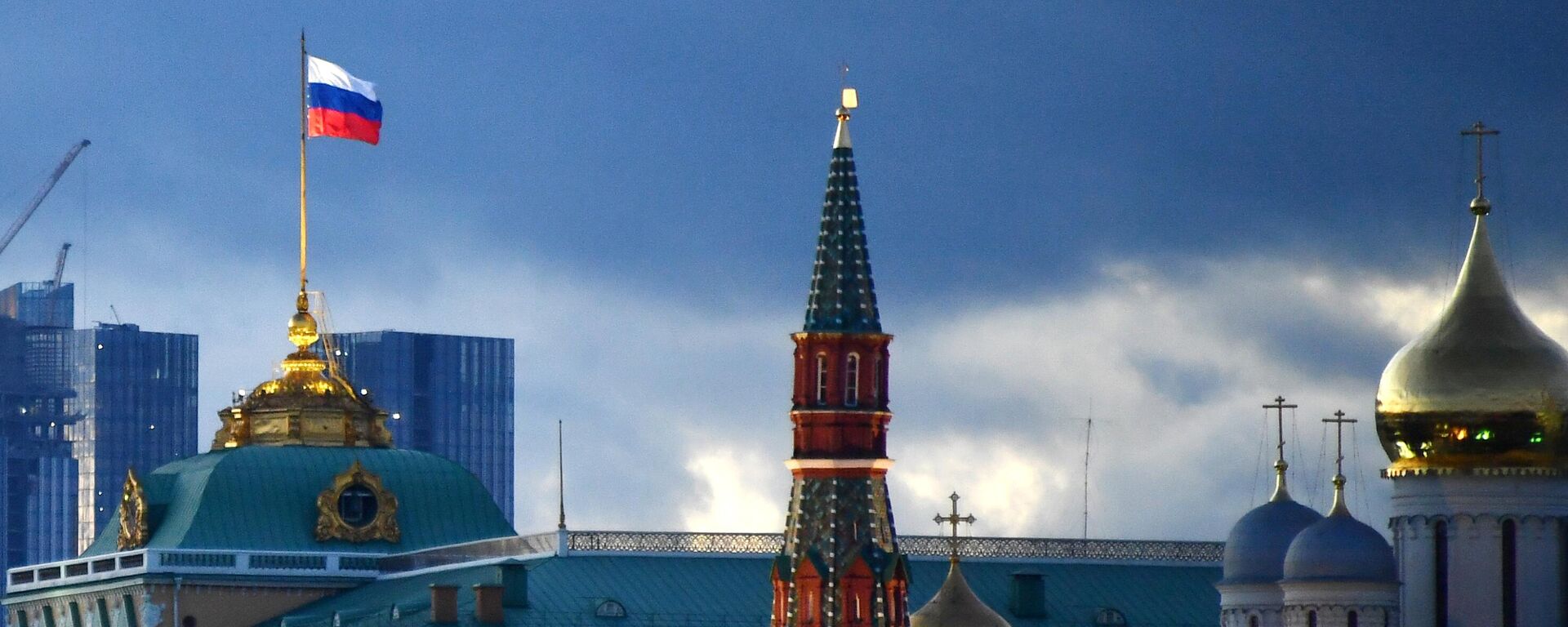
14 February 2022, 12:40 GMT
International relations scholars from the realist school have long argued that NATO expansion has made the alliance and the world less, not more, safe. John Mearsheimer, a preeminent realist from the University of Chicago, has
warned repeatedly that the further east the alliance presses, the more insecure Russia feels, and that the more insecure Russia feels, the more insecure the West becomes.
The advent of new armaments, including nuclear-armed hypersonic missile systems, has guaranteed Russia strategic leverage, albeit as a last resort to enemy aggression. After the United States renounced the 1972 Anti-Ballistic Missile Treaty in 2002, Moscow dusted off Soviet plans for hypersonic missiles capable of evading all existing and prospective air defense systems. These programs bore fruit in late 2017, when the Kinzhal hypersonic nuclear-capable aero-ballistic air to surface missile stepped into service with the Russian military. Other Russian systems,
including the Avangard hypersonic glide vehicle, the Zircon scramjet-powered anti-ship cruise missile, and the new RS-28 Sarmat intercontinental ballistic missile system, promise to help maintain the strategic balance between Russia and the Western bloc for decades to come.
China, Washington’s other strategic competitor, unveiled its DF-ZF hypersonic glide vehicle in 2019. But the US’s outsized defense spending has helped Washington in gaining the upper hand in the hypersonic race, with none of the half-dozen US hypersonic weapons designs in development anywhere close to being fielded.
Spending Our Way to Bankruptcy
Major NATO members including Germany, Italy, Spain, Portugal and the Netherlands have spent years dragging their feet on the bloc’s 2014 requirement to boost defense spending to at least 2 percent of GDP. The Ukraine crisis and renewed bloc pressure have helped overcome resistance, with the European Union alone announcing increases in spending of some
$211.5 billion over the coming four years. In the US, the Senate has approved a $817 billion military budget for fiscal year 2023,
$45 billion more than President Biden requested.
In the UK, Defense Secretary Ben Wallace has urged Prime Minister Johnson to push far beyond the 2 percent of GDP marker,
recommending that 2.5 percent of GDP be committed to defense by 2028, and calling the Ukraine crisis a “1937 moment.” Other senior current and former British officials have taken a similar tone, with General Lord Dannatt, former chief of staff,
demanding that Number 10 rethink its US-style “pivot” to Asia and dramatically ramp up spending on the Army to ends its status as the Royal Navy’s “poor cousin.”
Taken together, the Western alliance already spends about
half of the $2 trillion in global defense spending, and about
three times more than its so-called main
“strategic competitors” Russia and China do.
The ramped up defense spending comes against the backdrop of skyrocketing inflation, spiraling energy and food costs, and talk of a looming recession or even a stagflationary crisis (i.e. high inflation plus high unemployment and stagnant demand) on both sides of the Atlantic. Late last week, economists
told the Financial Times that the risks of the US and Europe slipping into recession have gone up sharply amid energy price crunch and the US Federal Reserve’s measures to raise interest rates to try to get inflation under control. Earlier this year, German industry leaders
warned that the coming economic crisis could be the European economic powerhouse’s worst since the Second World War.
The disconnect between the economic crisis and the defense spending hikes have not gone unnoticed among US and European observers. In the United States, alternative media and pundits from both
the left and
the right have taken note of Washington’s spending priorities favoring Ukraine and the military-industrial complex instead of ordinary Americans.
Last week, Massachusetts-based think tank National Priorities Project
calculated that the planned increase in the Pentagon’s budget alone could almost fund President Biden’s ‘Build Back Better’ investment plan, which was scuppered by lawmakers over its perceived prohibitive cost. Across the Atlantic, the Leibniz Institute for Economic Research recently warned that German Chancellor Olaf Scholz’s “historic” 100 billion euro defense spending plan would be
eaten up by inflation.
The escalation of the crisis in Ukraine in February of 2022 and the Western alliance’s rushed attempt to continue its expansion along Russia's northern flank exposed a soft underbelly of bureaucratic infighting rarely seen before. In May, after the Finnish and Swedish governments formally applied for NATO membership, Turkish President Recep Tayyip Erdogan declared that Ankara would block the two countries’ applications until Helsinki and Stockholm ended their association with the Kurdistan Workers’ Party, a Turkish Kurdish political party and paramilitary group which Turkey classifies as terrorists, but which Finland and Sweden do not. Publicly, the Nordic nations have rejected this blatant interference in their internal affairs, leading their future status as part of the alliance uncertain and spurning NATO officials’ hopes of formally announcing their acceptance into the bloc at the Madrid summit.
Turkey isn't the only country which has sought to take advantage of NATO’s requirement of unanimous support for new members being accepted. Last month, Croatian President Zoran Milanovic
threatened to instruct Zagreb’s permanent representative to NATO to vote against Finland and Sweden’s admission into the alliance until an election law dispute in Bosnia was resolved. “If I am blamed, I am prepared. I have said before, Croats in Bosnia are more important to me than the entire Russian-Finnish border,” Milanovic said in a press conference, adding that Turkey has shown the way on “how to fight for national interests.”
Destabilizer of Europe, and Beyond
While it touts itself as a
purely “defensive alliance” designed to protect its North American and European members and to “peacefully resolve disputes,” NATO has made numerous policy decisions over the past three decades which have destabilized its frontiers, including several wars of aggression against nations which posed no threat to any of its members.
The Western bloc began shifting to an interventionist approach immediately after the Soviet collapse, deploying 60,000 troops and staging aerial operations over Bosnia beginning in 1992 during the bloody civil conflict between Bosnian Muslims, Catholic Croats and Orthodox Serbs. NATO’s operations included establishing a no-fly zone, which monitored the skies and stopped flights from the Federal Republic of Yugoslavia (multiple Serbian jets were shot down during this ‘air policing’ mission), attacking Bosnian Serb militias, and forcing the Serbs to surrender large tracts of territory, including Sarajevo, through the Dayton Accords of 1995.
NATO’s successful ‘police action’ was followed up by 78 straight days of bombing of Yugoslavia in support of Kosovar Albanians in 1999, with the alliance launching over 2,300 missiles and dropping some 14,000 bombs, including cluster and uranium munitions in Kosovo and across the now former Yugoslavia. The aerial assault left as many as 5,000 people dead, and decades on, Serbia has reported a dramatic spike in oncological diseases attributed to the use of uranium cluster munitions, plus deliberate attacks on chemical plants and hazardous industrial facilities. The Balkan nation records nearly 60,000 new oncology patients each year, with a cancer rate
2.5 times above the European average for children.
NATO’s justification for the 1999 bombing was a desire to ‘protect’ Kosovar Albanians from ethnic cleansing amid clashes between Albanian militias with Serbian army and police forces. After the bombing stopped and NATO ground troops were introduced, over 200,000 ethnic Serbs living in Kosovo had to leave their homes, with the United States establishing a massive, permanent military base in the region known as Camp Bondsteel.
In 2001, after the 9/11 terror attacks on the Twin Towers in New York City and the Pentagon in Washington, the United States became the first NATO member to invoke Article 5 – the cornerstone section of the alliance’s treaty which deems an attack on one alliance member an attack on all and requires mobilization for effective defense. In the subsequent months, NATO forces invaded and occupied Afghanistan – the purported hiding place of 9/11 mastermind Osama bin Laden, with the mission of capturing him and bringing to justice, and ousting the Taliban government accused of sheltering him.
Bin Laden was found living in a mansion in neighboring Pakistan about a decade later, and assassinated by a US Navy SEAL team. Meanwhile, after successfully toppling the Taliban and establishing a Western-friendly government, NATO’s mission in Afghanistan morphed into a nation-building operation that would ultimately last nearly 20 years, but crumble in weeks in August of 2021 as the US and its allies departed from the war-torn country. Brown University’s Costs of War project has
estimated that some 176,000 people in Afghanistan died in the aftermath of the NATO invasion and occupation, with tens or even hundreds of thousands more feared to have perished from diseases, loss of access to food, water, and infrastructure. NATO and its allies lost more than 3,500 troops in the war, with the Costs of War Project calculating that the US military alone spent some
$2.3 trillion on the conflict.
In 2011, on the wave of the so-called ‘Arab Spring’ protests rocking much of the Middle East, a multi-state NATO-led coalition began another aerial campaign – this time in the North African nation of Libya. The 222-day bombing campaign, led by US, French, British, Canadian and Italian forces, was formally tasked with enforcing a United Nations resolution imposing a ‘no-fly zone’ prohibiting the forces loyal to Libyan leader Muammar Gaddafi from carrying out sorties against rebels. In practice, the operation saw NATO jets attacking thousands of Libyan Army targets, including over 600 tanks and armored vehicles, 400 artillery and rocket launcher installations, and other targets.
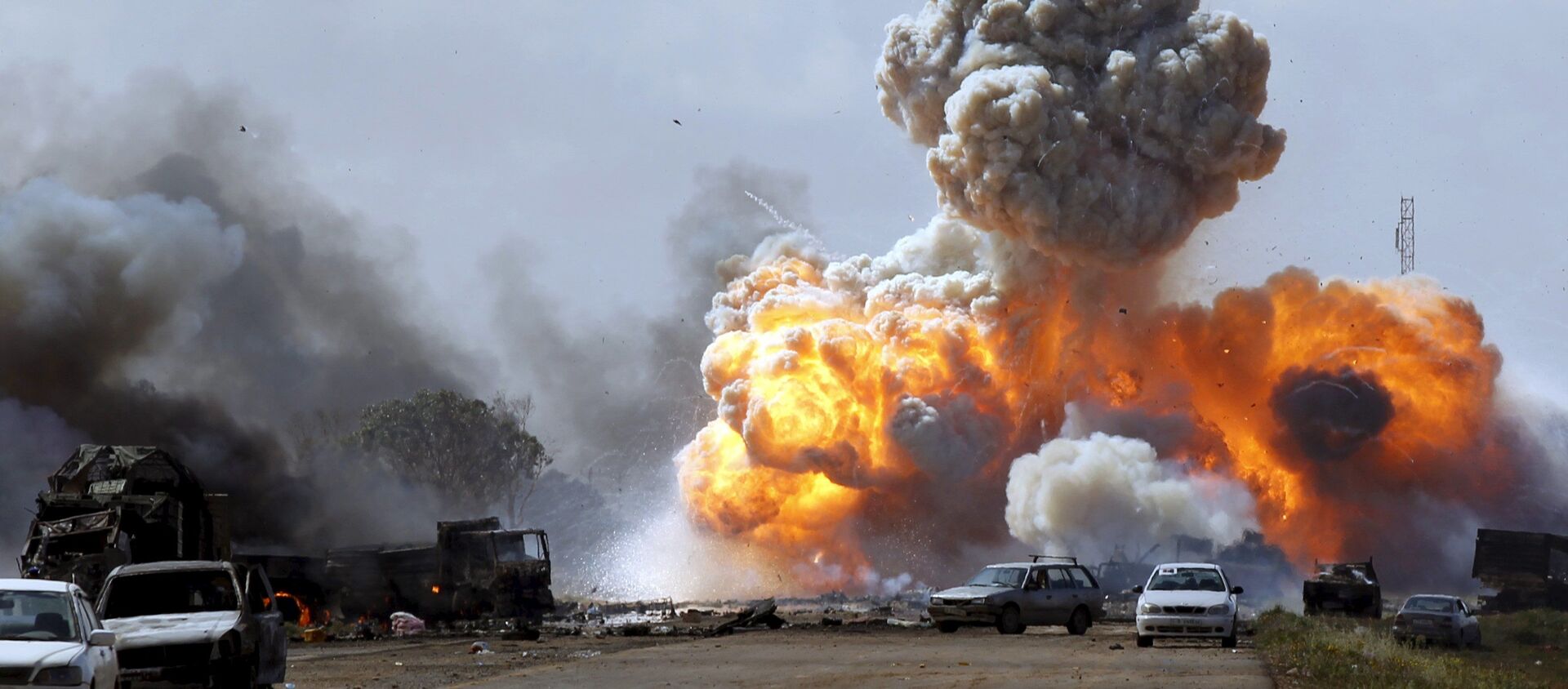
16 February 2016, 14:15 GMT
Effectively, it was a foreign-backed military intervention to overthrow the country’s government. The campaign succeeded, and Gaddafi was eventually captured, tortured and executed by a gang of thugs. NATO jets dropped over 7,700 bombs and missiles on the country,
once again including depleted uranium.
As many as 2,000 civilians were killed as a direct result of the intervention, but the true chaos awaiting Libyans only began after the Gaddafi government’s collapse, with the country turned into a failed state controlled by warring factions, including al-Qaeda* and human trafficking criminal groups.
The interventions in Afghanistan and Libya had a direct impact on European security, worsening, rather than improving it, with hundreds of thousands of refugees from the two countries fleeing to Europe in 2015, joining refugees and migrants coming from Syria and Iraq (two other countries destabilized by the United States), as well as Pakistan and Sub-Saharan Africa.
Its Enemy No Longer Exists
The North Atlantic alliance was founded at the dawn of the Cold War between the Soviet Union and the United States. In the aftermath of the Second World War, simmering mistrust between the erstwhile wartime allies boiled over into open hostility. In Europe, between 1947 and 1949, Moscow helped communists in Eastern European countries seize power, while in Western Europe, the US Central Intelligence Agency plotted to rig elections in Italy and France to prevent them from ‘turning red’, and helped Greek monarchists put down left-wing anti-fascist militants. NATO was founded in April 1949 to deter a potential Soviet invasion of Western Europe.
After West Germany was invited into NATO in 1955, the USSR established the Warsaw Pact alliance. For the next thirty years, NATO and the Warsaw Pact would stare one another down across the so-called Iron Curtain frontier between East and West. However, in the mid-to-late 1980s, Soviet leader Mikhail Gorbachev began chipping away at Moscow’s realist approach to foreign policy, replacing it with an idealism that held that the superpowers could end the confrontation between them and converge on matters affecting all nations, such as poverty and environmental crises.
Gorbachev’s reforms, which included pulling hundreds of thousands of troops out of Eastern Europe, and the signing of a pact with the US known as the Intermediate-Range Nuclear Forces Treaty, helped dramatically ease tensions between the superpowers and their respective blocs. In 1989, Gorbachev looked on helplessly as a wave of counterrevolutions rocked Eastern Europe, with the USSR itself overcome by political upheaval soon thereafter, and collapsing in December of 1991. With it, NATO’s raison d’etre – the “long, twilight struggle” against Soviet communism, also disappeared.
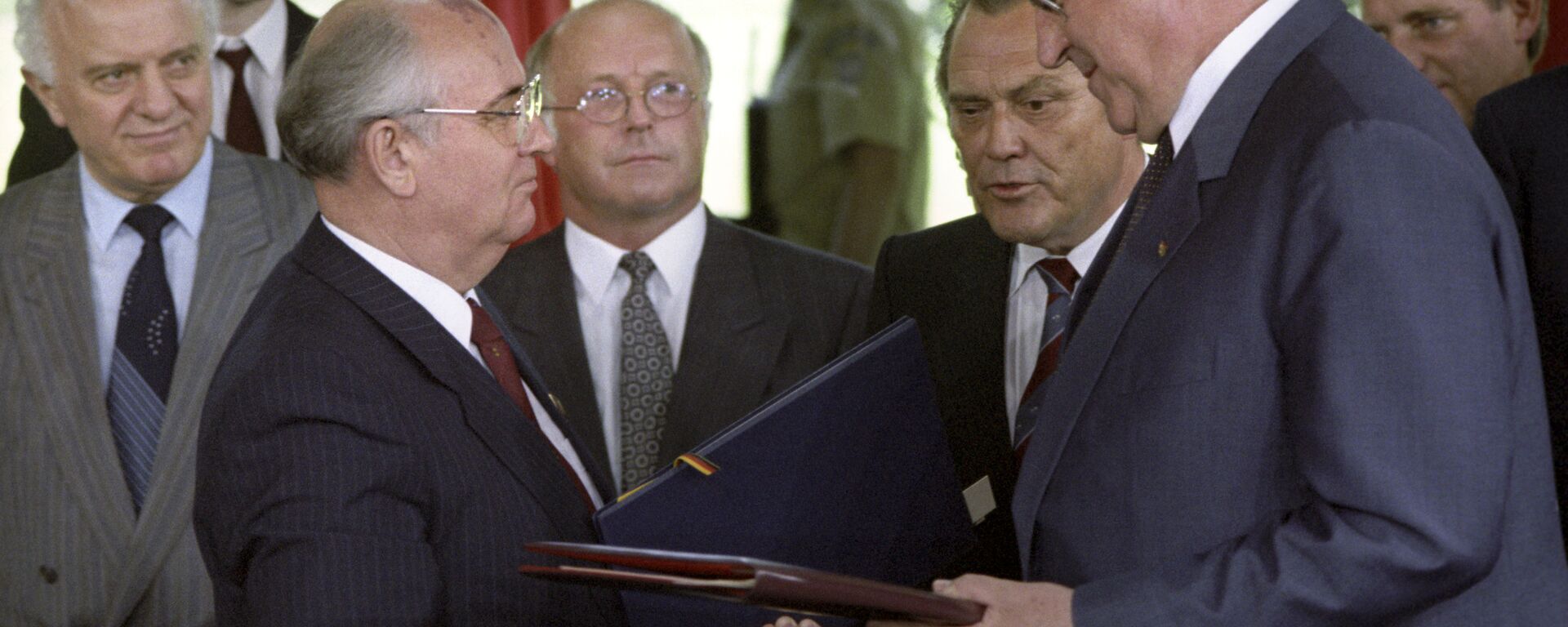
10 February 2022, 16:15 GMT
But despite the loss of its main adversary – the Soviet threat to Western liberal democracy and capitalism, NATO did not cease to exist. In November 1992, charismatic former Arkansas governor Bill Clinton took the White House, and, two years later, not only committed to strengthen NATO, but reversed his predecessor George H.W. Bush’s position on the alliance’s growth. Bush’s secretary of state James Baker famously promised Gorbachev in 1990 that the Western alliance would not expand “one inch east” beyond the eastern frontiers of a reunified Germany. Clinton broke that promise, and in 1999, after several years of negotiations, the first round of the bloc’s eastward expansion began.
George Kennan, the US diplomat, geostrategist and author of the famous 1946 ‘long telegram’ of advice on how to ‘contain’ the USSR, characterized the then-planned expansion of NATO a mistake of historic proportions. In an op-ed in the New York Times in 1997, Kennan
warned that “expanding NATO would be the most fateful error of American policy in the entire post-Cold War era,” and that it would be certain to “impel Russian foreign policy in directions not to our liking.”
Even Boris Yeltsin, the 1990s Russian President whose foreign minister Andrei Kozyrev once quipped that Russia
“has no national interests” besides abstract “universal human values,” criticized Clinton’s NATO expansion plans. In 1994, in one of the first inklings of the current NATO-Russia tensions, Yeltsin
asked “why” NATO was “sowing the seeds of mistrust” and threatening to plunge Europe into a new “cold peace.” Yeltsin never received a satisfactory answer, and in the decades to come, 14 Eastern European countries would be absorbed into the bloc, with each wave of expansion escalating tensions with Moscow further and further.
* A terrorist group outlawed in Russia and many other countries.
